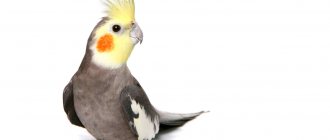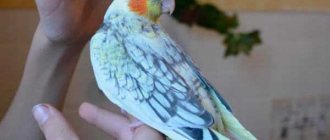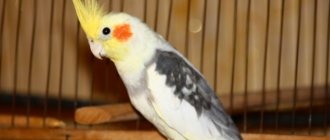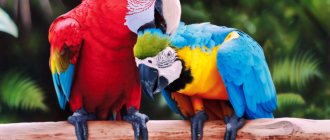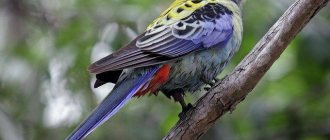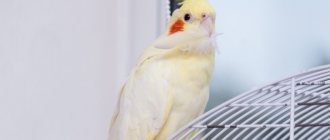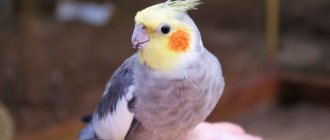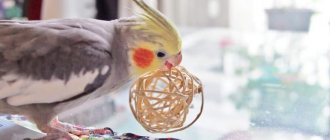Features of keeping cockatiels
Cockatiels are one of the noisiest creatures in the bird world.
Before you get a new pet, you should decide whether it is suitable for you and your family. Still, the character traits of this species will be a plus for some, but will irritate others.
Be sure to take this into account before purchasing a cockatiel so as not to create additional stress for yourself or the bird.
- 1. Cockatiels are noisy and active. If you don’t yet know whether the cockatiel parrot talks or not, then rest assured that with proper training, it will talk, and how. No, they won't broadcast incessantly, but get ready for morning singing and evening lullabies. Not all people tolerate sharp sounds well at this time of day.
- 2. They love family attention and do not tolerate prolonged loneliness. If you have a very busy schedule and are away from home most of the time, then this pet is not for you. Some birds require less attention, but their level of socialization will drop significantly.
- 3. There will be quite a lot of debris from the nymph. The bird has its own home, and it will definitely establish its own order there, and throw everything unnecessary outside the cage. Of course, feathers will fall out and fly in all directions. During free walks, the cockatiel may well find something and chew something.
- 4. Buying a bird is not the last financial investment. She will also need a cage with all the accessories, regular purchase of food, special toys and broken items in the cage, periodic examinations by a veterinarian and even treatment. The Corella will be a full member of the family and will require the necessary care in all aspects.
- 5. You also need to know how long a cockatiel lives at home. With a good standard of living, this pet will live for more than 20 years and will need care for all these years! Understand that this is not a toy for a few years, the parrot will be with you for a really long time. Corella may well witness how you finish your studies, find your soul mate and your children together graduate from school.
If none of this scares you away, then soon you will have a wonderful, very cheerful and incredibly loyal pet. He will happily greet you, wake you up in the morning and sit on your finger. All that remains is to prepare his future home.
Corella sings "My Neighbor Totoro"
Large breeds of parrots. Photos and description.
Cockatoo, funny crested parrot
One of the most beautiful parrots, they are particularly playful and highly intelligent. They don’t really like to talk, but they can learn a certain number of words. The lifespan is 70-90 years, so think about it before buying - such a bird will last a lifetime. There are many species of cockatoos, ranging in size from 30 to 70 cm and a wide variety of colors. All are united by a crest on the head and a special shape of the beak. By the way, their name comes from their beak: cacatua is translated as nippers, which resemble their beak. Photos of the most popular cockatoo species:
Yes, yes, these are all cockatoos: white, black, pink and red...
Giant feathered macaw
One of the most famous, large and colorful parrots. The largest breed of parrots. Probably everyone has heard about them, but not everyone can have such a parrot. Let's explain why:
— First of all, because of the high cost of the bird - prices for some can reach a million. This is due to the fact that macaws were actively caught for a long time and this led to the virtual extinction of some species, and macaws reproduce quite rarely;
“Also, these birds have a very strong beak: not only furniture, but also a family member can be damaged. Particular attention should be paid to their upbringing; if there is aggression on your part, the macaw can easily reciprocate.
— Due to its large size (up to 100 cm), the parrot requires a large room for keeping. In addition to a large cage, he also needs somewhere to fly.
— A sharp and very loud voice, which not everyone can get used to. Neighbors will probably hear it in the apartment, so it’s ideal to keep it in a private house to avoid conflicts.
If this does not stop you, we suggest looking at photographs of the most popular subspecies of macaw parrot. And in the material “How much do parrots cost in Russia”, you can find out where and for how much you can buy a feathered friend.
No comments, just admire these beauties:
The smartest gray parrot
Not the most beautiful of all pet parrot breeds. It has gray plumage and a red tail (the subspecies has a red-tailed gray). But, the unprepossessing appearance is fully compensated by the highest intelligence among parrots, amazing ability to learn language, emotional behavior and affection for humans (with proper upbringing). The size of the gray parrot reaches 35 cm. Life expectancy is up to 50 years. It’s better to buy a young chick so that the pet can get used to you, and it’s nice when you know that you taught the bird everything yourself.
In its natural habitat, the parrot spends all its time flying, searching for food and communicating with relatives. Therefore, in captivity, with provided living conditions, the gray parrot requires entertainment and attention like no other. Due to his high intelligence, he gets bored just sitting in one place in a cage, or even flying around one room. It is imperative that you either work with him daily - teach him conversation, various commands, or provide logic games so that the parrot has something to occupy his extraordinary mind. For the same reason, a parrot's cage should be a real impregnable fortress - it can easily open ordinary locks.
An interesting feature: the gray parrot is prone to dominance, so the cage should be placed either at a level no higher than the eyes, so as not to look down on it. Below you can see photos of this amazing bird:
Red-tailed parrot
Brown-tailed, common gray parrot
We have analyzed only the most popular varieties of parrots with photos and descriptions; you can learn about lesser-known birds in our following material: Rare breeds of parrots with photographs.
parrot, breeds of parrots, varieties of parrots
What types of cockatiels are there?
The natural color of these parrots is represented by a gray body, yellow head and bright orange cheeks. During artificial breeding, new, brighter colors were developed. Now you can find cockatiels with the following colors from breeders:
- White. There are two types: albino and just white. Differences in eye color. Albinos will have red eyes, while whites will have black eyes. Let's allow a light cream shade of plumage. The head and crest remain yellow.
- Whitewing. This color is characterized by white flight feathers, and the main feathers remain gray.
- Light grey. Somewhat lighter than usual gray individuals. The yellow head and crest are preserved.
- Pearl grey. In this color the feather has uneven pigmentation. The very edge is a rich gray color, and the middle of the feather is white. You can find individuals that have a cinnamon or yellow tint instead of white. Only females retain this unusual coloration for their entire lives. Males change color after molting.
- Cinnamon. The main plumage can take on various shades of brown.
- Dark yellow. In this case, the color varies from light cream to dark yellow.
- Lyutino. This color implies a yellow body color with white spots on the wings. The cheeks are bright orange.
- Blackwing. Representatives of this color have a back and tail that are much darker than the main gray color of the body. The wings are also darker and have white spots.
- Black. The entire cockatiel is a rich dark gray color. The breast is almost black in color; there are light spots on the wings. The cheeks are dark orange and may have a few black feathers.
The most common colors: gray and lutino - Sheki or spotted. The main shade of these representatives is gray. There are many white spots on the wings. The head is white, the tail should be white-yellow. Spotted cockatiels have a subspecies - the harlequin. In such birds, only the wings remain gray, the head and crest are yellow, and the main part of the feathers is white.
By crossing different colors of cockatiels, unusual and original colors are increasingly being obtained. But most of them are still gray. This coloring is considered natural. The brightest colors are obtained by crossing spotted representatives with other pigment carriers.
Who are Lutino parrots?
The cockatiel, or Nymphicus hollandicus in Latin, can be called one of the most attractive birds of the cockatoo family. They come from Australia, where they prefer to live in open natural areas near ponds, eucalyptus trees and bushes. The first mention of these bright and beautiful parrots dates back to 1846.
Corella birds have a miniature body with a length of 29–33 cm including the tail and an average weight of only 100 g. Corella Lutino (Lutino) are bright yellow parrots interspersed with white feathers and orange cheeks. The eyes of these birds are red, becoming dark cherry in color as they mature.
Important! Lutinos, unlike other cockatiels, may have small bald patches under their crest and wings.
The nature of the birds is very friendly. They are unpretentious. They have good intelligence, can remember an insult and, after a while, take revenge on their offender. The birds are extremely sociable and perceive their owner and his family as their flock. They feel very well the intonation with which they are addressed. Bird breeders recommend communicating with them by drawing out words in a sing-song manner.
Birds live on average 15 years, but there are recorded cases of centenarians whose age has reached 35 years.
Did you know? Magnetic storms, environmental and psychological problems, as well as diet significantly affect the process of breeding offspring in Corella Lutino.
If your birds are not subject to this kind of negative influence, but still do not produce the long-awaited offspring, you should make sure that there are parrots of different sexes in the cage, since the sexual characteristics of the lutino cockatiel are not easy to identify. There are 3 ways to determine the sex of cockatiels:
- squeaking pose: males spread their feathers, tail horizontal to the body, head down, and females raise their tail up, throw their head over their back;
- The face of males is only natural gray, turning yellow as they grow older, and the body color is more saturated. The female's face remains the same color as the chick's;
- DNA analysis.
The optimal time to buy a cockatiel is the second month of its life, when the chicks become independent and can already feed every 5-6 hours.
Birds are easy to train, and the lutino cockatiel imitates the human voice well, and also imitates the sounds of a bell, creaking doors, and others. How to distinguish a female from a male lutino: video
What should be in a cockatiel's cage for feeding and caring for them?
Caring for a cockatiel at home largely depends on its cage. It must be of sufficient size. Choose a cage that is at least 60 centimeters high and 50 centimeters wide. It is advisable that the rods be positioned horizontally or have several horizontal rods - the bird loves to climb, but it will not be comfortable for it on vertical ones. The size of the gap between the rods is recommended to be 1.9 centimeters, and the rod itself should be steel. Lead and zinc rods spoil the health of all birds due to the poisons they release.
The conditions for keeping cockatiels additionally require special equipment. Must be present:
- Drinker and 2 feeders. One of them will be for dry grain mixtures, and the second for fresh food and wet food;
- Several perches;
- Rocker;
- Nest or house;
- Special toys. These can be ropes, rope, plastic or wooden ladders, special balls and a mirror.
Additionally, you can install a special screen on the cage so that the food does not spill out of the cage when the nymph eats. It is useful to have special cleaning products in your arsenal. With them, cleaning the cage will be much easier, and in addition, such products are also good disinfectants.
Cockatiel diseases at home and treatment methods
The health of the cockatiel, like any other bird, depends on proper feeding and living conditions. Inadequate care and poor nutrition can cause serious illnesses that require veterinary intervention.
1. Stomatitis - the appearance of a yellow coating on the oral mucosa. It is treated by applying Biomycin powder to the affected areas using a thin brush or cotton swab.
2. Colitis - refusal to eat, diarrhea and trembling from chills. For treatment, you need to give Enteroseptol, the date is calculated according to the instructions of the veterinarian.
3. Poisoning - may be a consequence of a sudden change in diet, feeding stale food, or the appearance of mold in the cage. Symptoms include loose stools, refusal to eat, lethargy and a sick appearance.
If cleaning the feeder and drinker, cleaning the cage and replacing food does not help, you should seek help from a specialist.
4. Infestation with parasites - occurs due to unsanitary conditions in the cage.
The main symptom is spontaneous heavy molting and the appearance of bleeding wounds on exposed areas. Treatment is prescribed by a specialist who will correctly identify the pest and prescribe the necessary medicine.
5. Goiter diseases - appears due to poor nutrition.
Characteristic symptoms are loose stools and inflammation of the goiter. Treatment is carried out using activated carbon, which is crushed and added to the drinking bowl. If the bird refuses to drink on its own, you can use a pipette and drop the solution into the mouth 5-6 times a day.
6. Colds - the cause may be a draft or hypothermia.
The bird begins to sneeze, becomes lethargic and refuses to eat, with redness of the eyelids, runny nose and hoarseness in the voice. For treatment, you will need to move the cage to a warmer place, add more vitamins and protein to the food, and provide the pet with good care.
7. Eye diseases - occur from infection or some foreign body getting into the eyes.
The main symptom is redness of the eyes and swelling of the eyelids; the parrot itself begins to blink frequently and behave nervously. If washing with warm water with the addition of boric acid or furatsilin solution does not help, you should show the bird to a veterinarian.
8. Birds living in insufficiently spacious cages eventually begin to suffer from the regrowth of their beaks and claws.
To prevent the problem, you should review your pet’s diet and choose a larger enclosure or cage, placing several tree branches on its bottom.
If this does not solve the problem, you need to contact a specialist who can properly trim the cockatiel's claws and beak. You cannot do this on your own, as you can damage the blood vessels that are located along the edges of the beak.
Choosing a pet
To keep your pet healthy and happy, keep his house clean.
When we have a ready-made home for the cockatiel, we can choose a bird for ourselves. Where to choose it is your personal preference. It is more reliable to contact breeders who breed this particular breed of birds. From them you can learn all the nuances of keeping them at home, clarify what the bird does not like, create a balanced diet and look at the parents. Moreover, you will not need to be tormented by questions about how to determine the gender of your nymph. The breeder will definitely answer this question, because he knows from his own experience how to care for a cockatiel at home.
Obvious sexual characteristics in cockatiels appear from 3.5 months, but one can definitely say only after a year. How to distinguish a male cockatiel from a female from a photo is quite possible. The male is usually brighter in color than the female. There are also differences in the crest. The female has a wider and shorter crest, but the boy will have longer feathers, and the crest itself will be narrower. There are also differences in behavior. Males are more active, more sociable and love to sing. Girls are not so talkative. When boys sit, they rise high on their paws, while girls' bellies are almost at the same level as their paws.
The best age for cockatiels to move to a new family is 3-3.5 months. The chicks are old enough to be separated from their parents and young enough to undergo socialization with a new family. You can find out your approximate age yourself. The peculiarity of each growth period is reflected in the color of the plumage, the color of the eyes, paws, folds on the paws and the smoothness of the beak.
Young cockatiels are somewhat brighter and lighter in color, while adults are richer and darker. The crest of juveniles is not as thick as that of mature individuals. The eyes of young animals are almost black, and with age the iris becomes lighter. The beak and feet of young birds are pinkish-gray, and the older the nymph gets, the less pink and more gray appears on the beak and feet . The smoothness of the beak also indicates age. In very young birds it is smooth, but years of life make it rough.
Special attention should be paid to:
- Plumage quality. It is not worth purchasing a chick during the molting period, because the body is already under stress, and moving can seriously harm your health. Their first moult occurs between six months and 8 months. The feather should lie one to one, without bald spots or stickiness.
- Eyes. They should be round, in no case squinted. There should be no discharge or peeling on them. Pay attention to the shine in the eyes.
- Beak condition. It should not be deformed or injured, and not have any growths. The nostrils should be dry and free of any discharge.
- Paws. Nymphs have 4 toes on their paws. 2 “look” forward and 2 look back. The claws should be smooth and neat.
- Cloaca. It should be clean, just like the tail. Residues of feces on the cloaca and tail are a clear signal that the cockatiel is unhealthy.
Monitor the health of the bird.
In any case, the choice of a pet should be independent, because you are choosing a friend for a very long period of time. It is better to transport a parrot in a special bird carrier. When the nymph is at home, carefully transplant it into the main cage and do not touch it at all for a while.
Habitats
Photos of gray cockatiels
Nymphs are indigenous to Australia. Their main habitat is eucalyptus groves in river floodplains, as well as fertile steppes, in which there are enough solitary trees and tall shrubs. Small groups of cockatiels live in semi-deserts.
During the breeding season, cockatiels break into pairs, hatch chicks and take care of their offspring. The rest of the time they unite in flocks of 10-15 individuals. If the year is excessively dry, parrots move in large numbers closer to bodies of water.
On other continents, cockatiels are not found in the wild, although they are very popular to be kept instead of budgies in North America, Asia, Europe and in our country. Domestic parrots that fly away from their owners are not able to survive in the wild on their own. Therefore, you need to ensure that feathered pets do not have the opportunity to fly out of windows or doors into the street.
Adaptation to a new place
The place must be fully prepared at the time of move-in. You should not pull your cockatiel out of its carrier with your hands into its new home. Create a hallway by simply opening the carrier door and cage and placing them opposite each other. The bird must move from one place to another on its own.
It will take time to get used to your new home. This will take at least a day, and may take a week. The owner should under no circumstances disturb the parrot at this time. A new environment already frightens the animal, and excessive attention will only aggravate the cockatiel’s stressful state. After adapting to the place, you can establish contact with your pet.
Albino
If you cross two parrots, one of which has the lutino gene, which blocks the dark color, and the other has the white-faced gene, which blocks the yellow color, then there is a high probability of producing an albino cockatiel. In principle, an albino is a white-faced lutino. Albino parrots have red eyes that darken over time to a dark cherry color.
Taming the cockatiel
Usually taming does not require anything special or complex skills. If the bird was purchased from a breeder, then it is socialized from the beginning. Individuals from pet stores may be a little less attuned to humans, but this can also be resolved within a few weeks.
At first, just stay next to the nymph's cage for 20-30 minutes a day and talk to her . Increase your communication time every day. If there is no negative reaction and the bird approaches you, give it a treat through the cage. After a few days, open the cage and stick a tasty treat nearby so that the nymph becomes interested and comes up to take it. Then place the treat on your open palm so that the bird climbs onto your hand. When the cockatiel climbs onto your hand without fear, turn your hand so that it is comfortable for her to sit on your finger and pull the parrot out of the cage. This is how you can start taming your parrot.
Now you can pet and “sniff” your pet. You don’t have to worry about what cockatiels love. They love affection, attention and treats very much. The Corella parrot is not particularly demanding in terms of care, maintenance and feeding. But he is very demanding in communicating with his new family. She will need at least an hour of your attention every day in order not to lose the level of socialization.
You can teach a cockatiel to sing beautiful melodies
These birds are very good at learning various tricks and human speech. Males do most of the talking, whistling and singing. Girls are more modest and silent, but a lot depends on how often you talk to her. Any animal is set up for dialogue, and the more you talk to it, the more it will want to answer you.
The basis of proper training is praise and affection. Never swear at a bird. This will only scare her, but she will not understand what exactly upset you. Repeat the desired words or tricks systematically for 20-30 minutes a day. Immediately positively encourage any fulfilled desire - praise with words, stroke, give a treat.
When practicing commands, always accompany the action with one specific word. Let’s say, when learning to sit on a finger, say “sit,” move your finger under the paws (this is how the cockatiel will reflexively move its paws to the finger) and immediately give it a treat.
Pearl
This color is also called “pearl” and does not in any way affect the colors already present in the cockatiel’s plumage. However, this mutation gene affects the distribution of color throughout the parrot's body: it reduces the distribution of the gene responsible for gray color, while increasing the yellowness gene.
On some feathers, the pearl mutation gene produces a jagged, yellow pearl pattern. In some birds the pattern is clearly visible, in others light and dark colors smoothly flow into each other, erasing the clear boundary between them.
You can identify a pearl-colored cockatiel chick when its first feathers begin to open. Their colors alternate, making the baby appear spotted.
Nutrition
Grains must be present in the parrot’s diet.
It is a balanced diet that will be the main guarantee of the excellent health of the nymphs and their life expectancy. The ideal option would be a ready-made grain mixture for cockatiels and similar parrots. Don't be alarmed that they contain a lot of grass, grains or other granules. They should be the basis (at least 65%) of nutrition.
If the main food consists of whole grains, this can cause complications on the liver. All grain feed contains too much fat, which can undermine the health of the bird. Additionally, the diet should contain fresh fruit or vegetables, cooked beans, sprouted grains - these are natural sources of trace elements, water and minerals. Be sure to install a special chalk in the cage, it will be a source of calcium. It is especially necessary for females.
There is a list of prohibited foods for cockatiels:
- Almost all heat-processed foods.
- Any sweet, spicy or fatty food.
- Mushrooms.
- Raw legumes.
- Onion.
- Avocado.
- Mango.
- Persimmon.
- Papaya.
- Bird cherry.
- Foliage from tomatoes.
- Chocolate.
- Alcohol-containing products.
- Caffeine-containing products.
Change the water daily, as this is what most often provokes diseases in cockatiels. It often contains leftover food or droppings, which are sources of proliferation of viral and fungal cultures. Remove all raw food after 3-4 hours and throw it away, even if the bird has not eaten. Such products spoil very quickly and become moldy. You should not give more than one slice of any fruit or vegetable.
Cockatiels eat heat-treated vegetables. The daily portion for one bird of all types of food is
40 grams. The only thing not included is greens, which can be enjoyed in any quantity. These are the greens that are familiar to us, such as parsley, celery, dill, lettuce and spinach, as well as sprouted grains, dandelion foliage, tree buds, clover, and nettles. Wood sticks are necessary and loved by cockatiels. These can be fruit trees, birch, pine, linden, spruce.
Introduce each new product gradually. You should not overwhelm your bird with unfamiliar foods. Firstly, this can give a negative reaction from the gastrointestinal tract (loose stools), and secondly, the pet may completely refuse unfamiliar food.
Appearance
Cockatiels are small parrots, similar in size to young pigeons. Characteristic features of the species:
- body length 16 – 18 cm;
- tail length 12 – 15 cm;
- wing 15 -17 cm;
- body weight 90 – 150 g.
The feathers on the wings and tail are long and pointed. The paws are weak, the toes are thin, but their structure allows them to run quickly through the grass and tenaciously hold onto branches. Like all parrots, cockatiels have a strong beak, with which they playfully crack nuts and chew twigs. The cere is gray, the iris is brown.
On a note! The nymph's decoration is a narrow forelock on the head, with the help of which the bird expresses its mood. The crest distinguishes the cockatiel from other parrots, but also gives some resemblance to cockatoos, so for a long time they were considered relatives.
After conducting research, scientists found out everything about cockatiels and came to the conclusion: this is a separate species.
Features of caring for a cockatiel
Corellas are not very demanding when it comes to keeping them. It is important that they do not have dirt, have enough light and always have entertainment. Clean the cage regularly, and if you use bedding, choose only natural fillers. Sawdust is best.
Illumination and daylight hours are important. Don't place the cage in a dark corner, but don't place it close to a window either. Direct sunlight is undesirable. Daylight hours are 10-12 hours. It can be corrected by partially covering the cage in the summer, and by providing additional lighting with lamps in the winter. Too long a day can make the bird more aggressive, and too short a day can make it more apathetic.
Nymphs are contraindicated in drafts and sudden temperature changes. The temperature should always be between 20-25 °C. Birds need bathing in water at a temperature of 30-35 °C. These can be baths, or just a game when water flows from the tap. Cockatiels love baths.
There are no particular differences between the care of boys and girls. Differences may be present in nutrition, since even single females often lay eggs, they need additional calcium. Females also need a house or an imitation nest for comfort, but these objects will provoke the laying of empty eggs.
Whiteface
The white-faced color is one of the most interesting mutations that breeders have been able to achieve when breeding cockatiels. White-faced parrots differ from other mutations in that they do not have a yellow color. This color is also called “cheekless”, since birds with this coloring do not have the usual yellow or orange spots on their cheeks.
The most spectacular are the white-faced males, as they have a completely white head, without other shades. In females, the plumage on the head can be gray or brown.
Health
In general, this breed is not prone to diseases and is long-lived. Any diseases that occur in cockatiels are the result of neglect of the pet. Be attentive to the behavior of the bird, because it will not be able to tell you that it is not feeling well.
What health problems may exist:
- Feather loss.
- Feather and skin parasites.
- Violation of the structure of bones and beak.
- Infectious diseases.
- Disturbances in the gastrointestinal tract.
- Obesity.
- Amyotrophy.
- Avitaminosis.
Sound the alarm immediately and run to the clinic if the bird is already clearly sick. Most diseases are caused by poor or inappropriate nutrition and stress. Signs of health problems can be seen in behavior. The cockatiel becomes more aggressive, more active, or, on the contrary, very lethargic and constantly sleepy.
The pet may refuse any food or liquid. Check for breathing problems and any discharge from the nose, eyes or cloaca. Never treat a cockatiel yourself! Entrust examination and treatment only to a specialist!
Life expectancy and disease prevention
With proper care, Corella parrots live up to 20-25 years. In conditions of unsanitary conditions and nutritional deficiencies, birds can develop the following diseases:
- avitaminosis;
- obesity;
- gastroenteritis;
- dysbacteriosis;
- amyotrophy;
- violation of the structure of the beak and bones;
- parasitic infestations;
- feather loss and self-plucking.
To prevent the development of health problems, birds are provided with regular hygiene, adequate nutrition and timely veterinary care.
Important! If your cockatiel has growths on its beak, constipation, diarrhea, vomiting, baldness, inflammation of the skin, rapid or difficult breathing, the parrot should be immediately shown to a specialist.
Cockatiel breeding
At home, breeding of Corella parrots takes place without any problems or difficulties. It is not recommended to have chicks for individuals under one and a half years old, although females are capable of laying eggs as early as 8 months. At such a young age, the girl will only undermine her health with stress, and will not be able to fully hatch the chicks.
cockatiel egg
Attempts to have offspring will not always be successful. The egg may be unfertilized or stop developing at some stage. This happens and you should panic. Often not all eggs are fertilized, but they do not need to be removed from the nest - they help maintain the necessary warmth.
During the mating season itself and after laying eggs, it is very important to strengthen the diet with calcium and “fresh” vitamins. The expectant mother begins to have a serious calcium deficiency and needs to replenish it. The cockatiels will hatch and care for the chicks together. The chicks hatch in 2.5-3 weeks.
When the babies appear, there should be a lot of wet food in the feeder so that the parents are able to feed the young . The chicks are developing rapidly and in a little more than a month they will already be completely independent. However, you can say goodbye to them only at the age of 3.5 months.
Video: what you need to know before getting a cockatiel
Differences between male and female cockatiels
To successfully breed cockatiel parrots, you should be able to correctly determine their sex, so as not to buy two males or females in the store. To do this, you should rely on several distinctive features:
1) shade of plumage - females have a lighter color on the upper part of the body, there are dark round spots on the inside of the wings, the lower part of the body has a reddish tint. The spots on the cheeks are less bright than those of males, the crest and head have a yellowish tint;
2) the shape of the crest - in males it is narrower and bends upward, while in females it is wider and slightly inclined to the side;
3) tail width - males have a narrow tail with darker vertical feathers, in females it is almost twice as wide;
4) behavior - girls have a calmer character and are silent almost all the time, while males often sing and knock their beaks on the bars of the cage.
The age of a parrot can be determined by the presence of scales on its paws and the shape of the feathers on its crest. In adults they are more curved, in young people they are straight.
The older the bird, the lighter the eye color becomes. The first change of feathers occurs at 6-8 months; if the first molt occurred before purchase, then the age of the purchased parrot is approximately 8-9 months.
Habitat of noble parrots
Eclectus are considered native to the Solomon and Moluccas Islands, Sumba Islands, New Guinea and the Australian mainland.
As Eclectus populations increase from year to year, their nutritional needs also increase. Because of this, the population living next to birds refers to them as pests that cause great damage to crops.
How do they live in the wild?
Favorite habitats are the outskirts of tropical forests. The diet is plant-based (fruits, fruits, berries, unripe nuts, flowers, leaves, seeds). It is worth noting that Eclectus have a very long digestive tract, so the birds are excellent at digesting food high in fiber.
They choose hollows of tall trees for nesting, where they usually live for years. Their family relationships are interesting. When a female incubates eggs, she is fed by several males at the same time. Moreover, each male also has his own “harem” - 3-4 females, which he also takes care of. Females constantly “compete” with each other for the male’s affection. This unique reproductive strategy may explain the pronounced sexual dimorphism of Eclectus.
One clutch contains up to 2 eggs, the incubation of which lasts 1 month. Both the mother and all the feathered “fathers” are involved in feeding the cubs. The young begin to leave the nest at 3 months, but always remain to live next to their parents. Parrots become sexually mature at 3 years of age.
